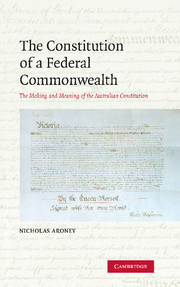Book contents
- Frontmatter
- Contents
- Preface
- Table of statutes and executive instruments
- Table of cases
- Introduction: Australia as a federal commonwealth
- PART I Federalism
- 1 Conceptualising federalism
- 2 Reframing the analysis
- PART II Federating Australia
- PART III Australian federation
- PART IV Conclusions
- Select provisions
- Bibliography
- Index
1 - Conceptualising federalism
Published online by Cambridge University Press: 05 August 2012
- Frontmatter
- Contents
- Preface
- Table of statutes and executive instruments
- Table of cases
- Introduction: Australia as a federal commonwealth
- PART I Federalism
- 1 Conceptualising federalism
- 2 Reframing the analysis
- PART II Federating Australia
- PART III Australian federation
- PART IV Conclusions
- Select provisions
- Bibliography
- Index
Summary
SOVEREIGNTY. I do not know how it has happened, that this word has crept into our political dialect, unless it be that mankind prefer mystery to knowledge; and that governments love obscurity better than specification.
John Taylor of Caroline (1820)The conventional approach
Conceptualising federalism is contentious and difficult. The conventional approach, particularly popular among constitutional lawyers and students of comparative government, states that the defining feature of a federal system is the existence of a ‘division of power’ between central and regional governments. The basic idea is that of a political system in which governmental power is divided between two territorially defined levels of government, guaranteed by a written constitution and arbitrated by an institution independent of the two spheres of government, usually a court of final jurisdiction.
The popularity of this approach among constitutional lawyers is in large measure due to its legalistic cast, particularly in the form initiated by prominent scholars such as A. V. Dicey, James Bryce and K. C. Wheare. The approach is also popular among leading writers on comparative politics, such as S. E. Finer and Vernon Bogdanor, apparently on account of its simplicity and scope. While parsimonious in its essential elements, the conventional definition is thought to capture an important set of features of a wide range of political systems that are commonly regarded as being ‘federal’ in nature.
There are a number of significant limitations in the conventional approach, however. First, as political scientists have often pointed out, the idea of a division of power fails to describe sufficiently the way in which living federal systems actually operate.
- Type
- Chapter
- Information
- The Constitution of a Federal CommonwealthThe Making and Meaning of the Australian Constitution, pp. 17 - 38Publisher: Cambridge University PressPrint publication year: 2009

